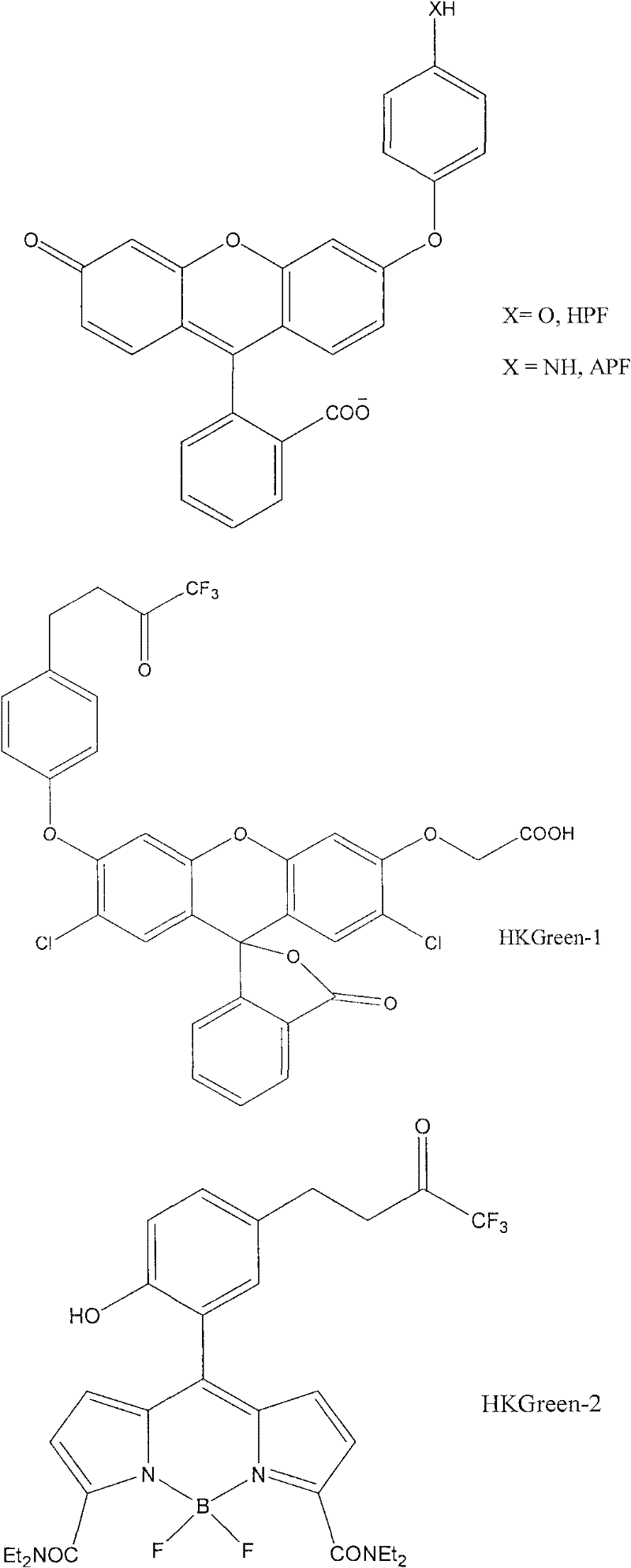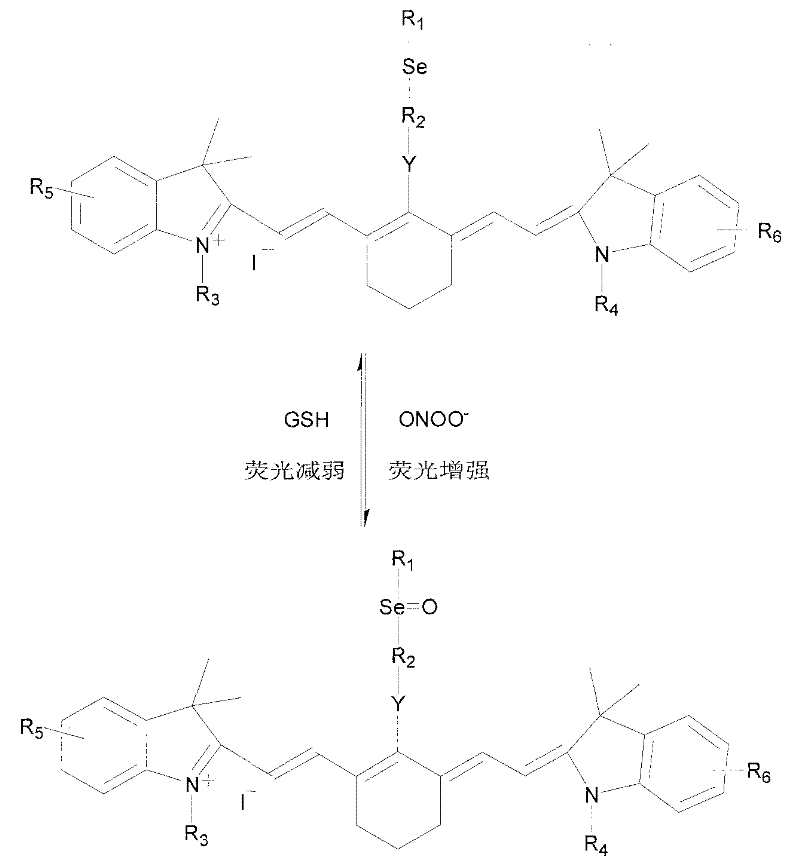Fluorescent probe and its application in reversible detection of peroxy nitrosyl
A technology of nitrosyl peroxide and fluorescent probes, applied in the field of fluorescent probes, can solve the problems of non-reversibility, non-reversibility of probes, and no application prospects
- Summary
- Abstract
- Description
- Claims
- Application Information
AI Technical Summary
Problems solved by technology
Method used
Image
Examples
Embodiment 1
[0046] Embodiment 1 (synthesis of probe):
[0047] Such as image 3 As shown, the structure of the probe compound used in the examples is represented by the code FSe-1, and the cyanine precursor used for the synthesis of the probe compound is represented by the code Cy7-Cl-1.
[0048] Synthesis of FSe-1: 0.6g Cy7-Cl-1 (available for purchase) and 2.5g p-phenylselenoaniline (Gaythwait, J.Chem.Soc., 1928, 2289.) were dissolved in 20ml of anhydrous N,N- In dimethylformamide, heat to 60-150°C to react for 2 hours. The solvent was evaporated under vacuum, and the obtained solid was purified by column chromatography to obtain the target compound FSe-1.
[0049] 1 H NMR (400MHz, CDCl 3 -D 1 )δ (ppm): 8.49 (s, 1H), 7.42-7.29 (m, 7H), 7.24-7.20 (m, 4H), 7.15-6.93 (m, 6H), 5.85-5.80 (m, 3H), 5.30 (s, 1H), 3.98-4.11(t, 2H), 3.41-3.42(d, 2H), 2.05-2.09(t, 4H), 2.05-1.66(m, 8H), 1.42(m, 12H). 13 C NMR (CDCl 3 -D 1 ,100MHz)δ(ppm):170.50,159.00,147.39,144.03,143.65,142.22,141.09,136...
Embodiment 2
[0052] Embodiment 2 (FSe-1 is to ONOO - optional):
[0053] The pH was controlled with PBS buffer solution. Add 10.0μM FSe-1 to a 10ml colorimetric tube, then add 20mM PBS, make up to 10ml with ultra-pure water, shake the solution well, and after equilibrating for 1min, add the above working solution into a fluorescent dish to measure the fluorescence spectrum. Fluorescence intensity changes with pH as Figure 4 shown. Figure 4 It shows that the fluorescence intensity of FSe-1 does not change significantly in the range of pH 4.0 to 8.5, that is, in the system of pH 4.0 to 8.5, FSe-1 can be used to detect ONOO - .
[0054] In order to simulate physiological conditions as much as possible, the following experiments were all carried out under the condition of pH=-7.4 (PBS buffer solution, the concentration was 20 mM), and the probe concentration was still 10.0 μM.
[0055] Add 10.0μM probe to a 10ml colorimetric tube, then add 20mM PBS pH 7.4, add ultrapure water to 5ml, sh...
Embodiment 3
[0056] Embodiment 3 (FSe-1 is to ONOO - quantitative detection):
[0057] Add 10.0μM FSe-1 to a 10ml colorimetric tube, then add 20mM PBS pH 7.4, add ultrapure water to 5ml, shake well, then add different concentrations of nitrosyl peroxide, and finally dilute to 10ml with ultrapure water . Shake the solution evenly, equilibrate for 10 minutes, pour the working solution into a fluorescent dish to measure the fluorescence spectrum, take the maximum value of each fluorescence spectrum, and input it into the software OriginPro 8.0 to obtain a linear working curve.
[0058] Concentration of nitrosyl peroxide after constant volume: 0, 1.0, 2.0, 3.0, 4.0, 5.0, 6.0, 7.0, 8.0, 9.0, 10.0μM.
[0059] Figure 6 (a) means with ONOO - Fluorescence intensity and displacement changes of the concentration change system, indicating that with ONOO - With the increase of the concentration, the fluorescence of the system will be blue-shifted while obviously enhanced; Figure 6 (b) shows tha...
PUM
 Login to View More
Login to View More Abstract
Description
Claims
Application Information
 Login to View More
Login to View More - R&D
- Intellectual Property
- Life Sciences
- Materials
- Tech Scout
- Unparalleled Data Quality
- Higher Quality Content
- 60% Fewer Hallucinations
Browse by: Latest US Patents, China's latest patents, Technical Efficacy Thesaurus, Application Domain, Technology Topic, Popular Technical Reports.
© 2025 PatSnap. All rights reserved.Legal|Privacy policy|Modern Slavery Act Transparency Statement|Sitemap|About US| Contact US: help@patsnap.com



